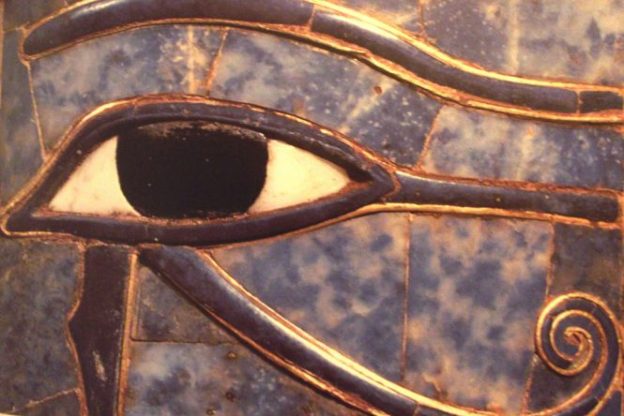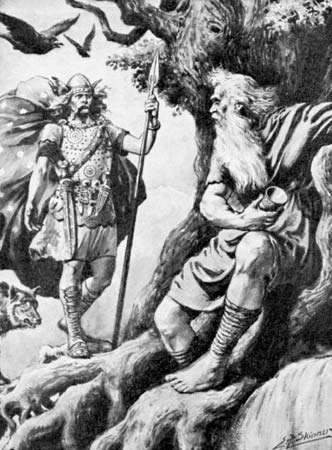What do the Egyptian god Horus and the Norse god Odin have in common? Both of them are said to have the sun and moon as their eyes. The difference is that this belief about Horus dates back to very early Egyptian religion. As far as I can tell, the same statement about Odin comes from some 19th and 20th century writers.
Like many Egyptian deities, Horus had a very long career, beginning as a falcon-headed sky god with the sun and moon as his eyes, to symbolize his all-seeing nature. As time went on the myth changed. As Horus the sky-god was identified with Horus the son of Osiris, his “moon” eye was the one damaged when he fought Set. (Don’t feel too bad for him – Set lost his testicles.)
The magician-god Thoth restored his eye, known as the Wedjat, meaning “whole”. Despite this, the damaged, left eye was supposed to be the moon, waxing and waning as it healed from its damage each month.
Odin, on the other hand, lost his eye voluntarily. He approached the giant Mimir, who guarded a well that granted wisdom to whoever drank from it. The giant told him that the price would be one of his eyes. Odin, to give him credit, was as ruthless with himself as he was with his followers, and sacrificed the eye. What exact benefit he received is not spelled out in the myth, but he seems to have felt it was worth it.
‘Why do you question me? Why do you test me?
I know everything, Odin, where you hid your eye
in the famous Well of Mimir’
Mimir drinks mead every morning
from the Father of the Slain’s wager — do you understand yet, or what more? (Vsp. 28)
From the Prose Edda (Gylfaginning) we have:
…there is where Mimir’s well is, which has wisdom and intelligence contained in it, and the master of the well is called Mimir. He is full of learning because he drinks of the well from the horn Giallarhorn. All-father went there and asked for a single drink from the well, but he did not get one until he placed his eye as a pledge. (Snorri goes on to quote the verse from Vsp. above.) 14-5.
Later, when the Ragnarök begins:
When these events take place, Heimdall will stand up and blow mightily on Giallarhorn, and awaken all the gods and they will hold a parliament together. Then Odin will ride to Mimir’s well and consult Mimir on his own and his people’s behalf. (51)
Or, as Völuspá has it:
Loud blows Heimdall, his horn is aloft. Odin speaks with Mim’s head. (46)
This is all we have in the lore of Odin’s eye. Nowhere is the sun or the moon mentioned. For that, we have to look to a more modern mythology.
19th-century nature-myth has a lot to answer for. And, since the books that popularized these ideas are out of copyright and thus available in cheap editions or free online, these ideas continue to spread. For example:
“The eye of the god of heaven is the sun, which enlightens and penetrates all things; his other eye is the moon, whose reflection gazes out of the deep, and which, at last, when setting, sinks into the ocean. It also appears like the crescent-shaped horn with which the Jotun drew the draught of wisdom.” (Wägner: 86)
Nature-myth starts from the assumption that mythology was a primitive sort of science, trying to explain the world around us using the actions of deities. So thunder was the sound of Thor’s chariot-wheels as he rode through the sky.
Odin’s eyes could be the sun and moon if he was a supreme god, preferably a sky-god. (Like Horus, for example.) Since one of Odin’s titles is All-Father, and he is clearly head of the Asgardian pantheon, there is no question that he is the supreme god. The fact that he was associated with war, with accompanying Valkyries, and the Wild Hunt streaming across the sky, however, suggests storms rather than the sun. His name comes from the word óðr, “raving, possessed”, with the –in suffix making it a name. (Puhvel: 193)
Norse mythology does have a sky-god like Horus, but he seems to have faded out of the picture by the time the myths were being recorded. His name is Tyr in Old Icelandic, or Tiw or Ziu in Old English and German. His name can be traced back to an Indo-European root word meaning “sky”. Odin seems to have displaced him as head god, and one 20th-century writer tried to reconcile this:
The eye of Odin (really *Djevs) is an emblem of the sun and Mimir’s drinking mead from it every morning is a representation of the sun’s rising just as the hiding of the eye is the sun’s setting. Mimir’s name appears to be connected with the Latin memor, “memory” and hence with wisdom: the myth then develops into a tale of a Sky God who pledged one eye in return for the gift of wisdom. (Branston 114.)
(Norse myth is already supplied with a sun and moon, with their own myth, but that doesn’t mean there couldn’t be another one. It’s just that the sources don’t give us any grounds to think so.)
If we accept it as modern mythology, there are some interesting interpretations that open up. Carla O’Harris, posting in the Völuspá discussion group, said:
Moon (other eye) thrown into the Well = Moon Going Below the Waters = Moon in the Underworld, while the Sun is in the Above-World : One eye always visible, while the other is “beneath the waters” (= in the underworld).
Here the Sun and Moon would not literally be Odin’s eyes, but metaphorically, akin to Huginn and Muginn. In other words, the Sun sees all and reports it back to Odin, and the same with the Moon.
Which is an interesting way of thinking about it, and takes us away from the implication of nature myth (i.e.: our ancestors were stupid) and goes back to the original myth and Odin’s urgent, driven search for wisdom and knowledge from whatever source, and at any cost.
The symbolism of Odin’s two eyes, like his two birds, point towards different ways of gaining widsom and understanding of the world. We know that Odin was a great battle-strategist, full of cunning, but that he also practiced magic and shaman-like trancework. The sun and moon motif is a way of expressing his two modes of acting in the world, both practical and magical.
Edda, Snorri Sturluson/Anthony Faulkes, Everyman, London, 1987.
The Poetic Edda, Carolyne Larrington (trans.) Oxford UP, 1996.
Branston, Brian 1980: Gods of the North, Thames and Hudson.
Guerber, H. A. 1992: The Myths of the Norsemen, Courier Corp.
Puhvel, Jaan 1989: Comparative Mythology, John Hopkins University Press, Baltimore and London.
Wägner, W. (trans. M. W. MacDowell and ed. M.S.W. Anson) 1880: Asgard and the Gods, W. Swan Sonnerschein and Allen.
If you like the Eye of Horus, click here.




Pingback: Will the real sun-god (dess?) please stand up? |
Vishnu Vishvarupa’s eyes sun and moon

LikeLike
The idea of sun and moon as eyes clearly appeals to many peoples, and you can see how it works, metaphorically. I don’t know about Vishnu, but it’s interesting that both Odin and Horus have a damaged eye that becomes the moon, the less-bright eye.
LikeLike
Odin son of Burr and grandson of Buri. Buri is the first god.
Shukra son of Bhrigu and grandson of Brahma. Brahma is the first born creator.
LikeLike
There are some references to Asura as demons which is a modern rendition. There is no pure evil and good in indian literatures. Every being is a play of 3 gunas, Satvic, Rajas, Tamas. Asura are generally the beings who are more materialistic and Rajasic in nature. Devas and Asuras are half brothers and interchangeable. Agni and Varuna were Asura’s who were elevated to Devas. Bali will become Indra of next manavantara. 🙂
LikeLike
Pingback: Angry Bird: Horus the Warrior – WE ARE STAR STUFF